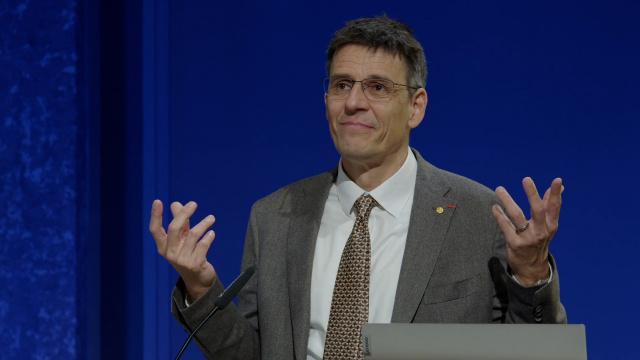Exoplanetary revolution! – Nobel Prize winner Didier Queloz gives a talk at the Academy’s General Assembly
The search for planets beyond the Solar System has been underway for three decades now, and Didier Queloz has been behind the telescopes and spectrographs from the beginning. The Swiss astrophysicist guided participants and guests through this period, from the discovery of “hot Jupiters” that orbit their own stars in just a few days to the search for signs of life. You will find a recording of his presentation in this article and on the MTA’s YouTube channel.
“I did my PhD with the help of this instrument, so I know all its little ins and outs – it was called ELODIE”, said Didier Queloz in his presentation, pointing to the spectrograph on which he and his supervisor, astronomer Michel Mayor, had discovered the first planet orbiting a Sun-like star outside our Solar System back in 1995. This was 51 Pegasi b, a planet with a mass comparable to Jupiter’s but orbiting very close to its star. In exoplanetary research jargon, a “hot Jupiter”.
 Didier Queloz Source: MTA’s YouTube channel
Didier Queloz Source: MTA’s YouTube channelDidier Queloz is a professor of physics at the University of Cambridge and the University of Geneva, and since 2021 he has been the founding director of the Centre for the Origin and Prevalence of Life at the Zurich University of Technology. Queloz shared the 2019 Nobel Prize in Physics with his supervisor Michel Mayor and Canadian-American astrophysicist James Peebles for discovering the first planet orbiting a Sun-like star outside the Solar System.
In his presentation, Queloz sped through the history of our universe and the three thousand years of the studying of star systems to provide some context for the last thirty years – when research into planets outside our solar system could really begin. The statistics on the characteristics of more than 5,000 known exoplanets today tell us as much about the properties of distant star systems as they do about the current limitations of our measurement methods: until recently, there was little chance of detecting truly Earth-like planets, precisely because of our planet’s small size and relatively long orbital period.
In the second half of his presentation, the Swiss astrophysicist talked about the search for detectable traces of life on exoplanets. From the reconstructed prehistory of Earth, we can see that living things leave very obvious traces in a planet’s atmosphere. And such traces – for example, the presence of oxygen or tell-tale proportions of certain gases – can now be studied in relation to exoplanets as well. To hear how, listen to the speaker’s talk by clicking on the player below.
